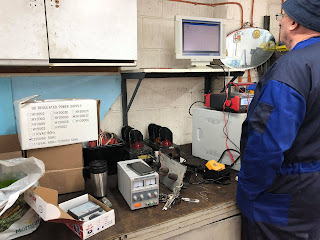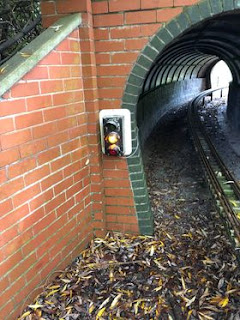 Busy busy busy!
Busy busy busy!
Good afternoon to all my blog readers that is if you have not given up on me and my lack of posting? I have been on and off the radio but not really any news out this way. I will say that this retirement gig sure keeps me busy! I am the type of person that has to be doing something, it's very hard for me to sit idle and listen to the bird's sing. My hat goes off to those who can sit and just relax, I call it doing nothing but those who practice it call it recharging the batteries. Well maybe sometime I will get to that point but at this point in my life, I like to keep busy. Before I retired I wanted to make sure that when I did I kept busy. To accomplish this Julie and I agreed (as I drive her NUTS if I have nothing to do) to purchase a fixer-upper home. Funny thing when you mention that to a real estate agent their version of a fixer-upper is what I call a "dump"!
We ended up getting a place that needs some "remodelling" and some outdoor stuff done and just enough to keep me busy. There was some outdoor medium to major projects I wanted to complete before the snow flies and down here on the East coast that can be very soon. The projects are now finished but unfortunately, it had put my ham radio activities on hold for most of the summer months. Winter means indoor work and I plan to slow the pace down a bit so that I am not to really tired in the evenings.
As I look back I have been retired for over a year now and the time is just flying. Before I retired I had a conversation with some gents who were already retired and they told me the following:
- It is going to take some time getting used too.....very true it took me about 6 months to get into a routine.
- You will feel less stressed..... to be honest, I did not feel stressed at the time BUT once I retired I began to realize I had become accustomed to the stress level and it was my unhealthy normal. I now can say that I really was stressed and am now much more content.
- You will forget what day of the week it is........good lord I just can't tell you how many times I have to really stop and think of what day it is.....never thought that would be me!
You will be busier than when you were when working fulltime........ true that!!
I am not sure if I missed any retirement life lessons but if I did feel free to chime in. Now that fall is here it's time to slow down sure the projects are still ongoing but I am going to practice the last bit of advice my retired buddies told me that that is "If it does not get done today it can wait until tomorrow or the next day" My next retirement life lesson is going to be.....make sure I fit time in for my hobby as it too is doing something!
Mike Weir, VE9KK, is a regular contributor to AmateurRadio.com and writes from New Brunswick, Canada. Contact him at [email protected].
 Hunting For NDBs in CLE261
Hunting For NDBs in CLE261
 |
| AP-378 Mayne Island, BC |
It's CLE time again!'CLE's are 'Co-ordinated Listening Events, and NDB DXers around the world focus their listening time on one small slice of the NDB spectrum.
This time the hunting ground is from 190.0 - 1740.0 kHz!
The challenge this time is to log just one (1) beacon from as many 'radio countries' as you can. In North America and other regions, an individual state or province counts as a radio 'country', so there are plenty of opportunities to fill your logbook.
Propagation on MF has been excellent this past week and hopefully will continue to be good.
A challenge target for listeners in North America is AP - 378kHz on Mayne Island, BC which is about 1/2 mile from me just down the beach! But 'AP' is a challenging target since, from what I can tell, has virtually no ground system. Although it has been heard as far south as Texas, it has never been heard further east than Nebraska. Listen for AP's upper sideband on 378.411kHz with your receiver in the CW mode.
When tuning for NDBs, put your receiver in the CW mode and listen for the NDB's CW identifier, repeated every few seconds. Listen for U.S. NDB identifiers approximately 1 kHz higher or lower than the published transmitted frequency since these beacons are modulated with a 1020 Hz tone approximately.
For example, 'AA' near Fargo, ND, transmits on 365 kHz and its upper sideband CW identifier is tuned at 366.025 kHz while its lower sideband CW ident can be tuned at 363.946 kHz. Its USB tone is actually 1025 Hz while its LSB tone is 1054 Hz.
Often, one sideband will be much stronger than the other so if you don't hear the first one, try listening on the other sideband.
Canadian NDBs normally have an USB tone only, usually very close to 400 Hz. They also have a long dash (keydown) following the CW identifier.
All NDBs heard in North America will be listed in the RNA database (updated daily) while those heard in Europe may be found in the REU database. Beacons heard outside of these regions will be found in the RWW database. These databases have recently been re-vamped and are slicker than ever before!
From CLE coordinator Brian Keyte (G3SIA), comes the following CLE info:
Our October Coordinated Listening Event is less than a week away.
Something very straightforward, but it is a first-time idea and it should be
good for everyone - including first time listeners.
It is a ‘One per Radio Country’ CLE!
Days: Friday 23 Oct. - Monday 26 Oct.
Times: Start and end at midday, local time at the receiver
Target: ONE NDB from each radio country
QRG: 190.0 - 1740.0 kHz
Yes, please log JUST ONE NDB from each radio country (not DGPS, NAVTEX,
Amateur or UNID).
All our radio countries are listed in the NDB List Website
(http://www.ndblist.info/ndbinfo/countrylist.pdf) There are 373 of them!
However most of the countries will be out of range for you and several are
without any active NDBs at all:
Region Radio
Countries
-------------- -------
N. America 66
C. America 35
S. America 20
Europe 63
Africa 68
Asia 60
Oceania 49
Antarctica 5
Int. Waters 7
-------
373
(UNIDs 8)
Even listening from the best location possible you will do very well if you
log 50 countries. Reaching 100 will be magnificent!
(If you would like one or more of our attractive listening awards, this
would be an ideal CLE -
Please see http://www.ndblist.info/ndbinfo/NDBAwardsList3.5.pdf)
Please look out for extra information in the Final Details in a few Days,
with advice on log-making, etc.
73
Brian
---------------------------------------------------------------------
From: Brian Keyte G3SIA ndbcle’at’gmail.com
Location: Surrey, SE England (CLE coordinator)
---------------------------------------------------------------------
If you are interested in some remote listening - maybe due to local difficulties - you could use any one remote receiver for your loggings,stating its location and with the owner’s permission if required.
A remote listener may NOT also use another receiver, local or remote, to make further loggings for the same CLE.
These listening events serve several purposes. They
• determine, worldwide, which beacons are out-of-service or have gone silent since the last CLE covering this range
• will indicate the state of propagation conditions at the various participant locations
• will give you an indication of how well your LF/MF receiving system is working
• give participants a fun yet challenging activity to keep their listening skills honed
Final details can be found at the NDB List website, and worldwide results, for every participant, will be posted there a few days after the event.
The NDB List Group is a great place to learn more about the 'Art of NDB DXing' or to meet other DXers in your region. There is a lot of good information available there and new members are always very welcome. As well, you can follow the results of other CLE participants from night to night as propagation is always an active topic of discussion.
You need not be an NDB List member to participate in the CLEs and all reports, no matter how small, are of much value to the organizers.
Remember - 'First-time' logs are always VERY welcome!
Reports may be sent to the NDB List Group or e-mailed to CLE co-ordinator, Brian Keyte (G3SIA), whose address appears above. If you are a member of the group, all final results will also be e-mailed and posted there.
Please ... give the CLE a try ... then let us know what NDB's can be heard from your location! Your report can then be added to the worldwide database to help keep it up-to-date.
Have fun and good hunting!
Steve McDonald, VE7SL, is a regular contributor to AmateurRadio.com and writes from British Columbia, Canada. Contact him at [email protected].
 LHS Episode 373: GridTracker Deep Dive Part 3
LHS Episode 373: GridTracker Deep Dive Part 3
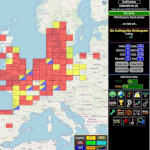
Welcome to Episode 373 of Linux in the Ham Shack. In this episode, we have a roundtable discussion with several of the contributors to the GridTracker.org project. We explore all the changes in GT from Part 2 through the recording date and also look at the new direction of GridTracker as an organization. GT is expanding in mentoring, STEM education, community and much more. Thank you for listening and have a great week.
73 de The LHS Crew
Russ Woodman, K5TUX, co-hosts the Linux in the Ham Shack podcast which is available for download in both MP3 and OGG audio format. Contact him at [email protected].
 The return of…
The return of…
Yes I am sort of back at it, but the family problems have not gone away.
I am currently working on a signalling system for a local model railway club.
This is a quite a big arrow to my bow, as I am not quite sure what I am doing yet? A big learning curve is required to take it all in. I have to take out the old analogue system, that is operated by a creaking relay logic system, and move it over to a more advanced software/hardware driven system, with a RS485 data highway switching the signals.
It should keep me my mind active for another couple of years, especially as all rally visits at weekend now have been cancelled due to Corona..
Steve, G1KQH, is a regular contributor to AmateurRadio.com and writes from England. Contact him at [email protected].
 AmateurLogic 148: 15 Years of AmateurLogic
AmateurLogic 148: 15 Years of AmateurLogic
AmateurLogic.TV Episode 148 is now available for download.
Celebrating 15 Years of AmateurLogic.
Peter, VK3PB joins for an update. Tommy is Getting Started With The IC-705. George has some Simple and Useful Transistor Projects. Emile Calibrates With WWV Until It Hertz.
Announcing the winner of the Icom IC-705 transceiver and prize package giveaway.
2:10:02
George Thomas, W5JDX, is co-host of AmateurLogic.TV, an original amateur radio video program hosted by George Thomas (W5JDX), Tommy Martin (N5ZNO), Peter Berrett (VK3PB), and Emile Diodene (KE5QKR). Contact him at [email protected].
 Ham Radio Antennas For Apartments
Ham Radio Antennas For Apartments
There are many challenges for today’s amateur radio operators. Low sunspots and poor propagation, Covid-19 virus limiting ham club meetings and normal fraternizing of local hams, HOA’s and other limits on outside antennas are real and must be dealt with. This also limits the help of ELMERS who can help new hams to understand how to cope with these problems.
One of the biggest problems is the limitations of apartment living. Many older hams have been forced to downsize as well as younger hams who cannot afford a single family home face these challenges daily. I hope I can provide some help for this challenge.
First let us consider the type of apartment. If a first floor apartment- consider moving. Really being on a higher floor is a big help with antennas. OK, well that can be dealt with anyway. Does the apartment have a balcony? How about a screened in porch. Are the windows small, or picture window size? Is there access to the roof? Are the walls concrete, wood or full of steel? Does the apartment management allow antennas? These are valid considerations and will affect antenna choices.
Not all antennas are equal. The half-wave dipole is the basis of comparison for antennas. Mobile whip antennas for HF are usually less than 20 percent efficient. However many apartment dwellers have operated using whips installed on their balconies.
Magnetic loop antennas of 1 to 3 meter diameters have been used successfully even they are about 40 to 60 percent efficient. Larger loops of 30 to 50 feet circumference can be used multiband operation with 60 to 80 percent efficiency. Fortunate amateurs that can install an end fed antenna can see 60 to 90 percent efficiency depending on the frequency of operation.
How does efficiency factor into antenna selection? The old saying “The bigger the better” certainly applies. Assuming a 100 watt transmitter, 50 percent efficiency would indicate a 3 dB loss of received and transmitted signal. Many sources state that the receiving station would hardly notice a reduction from 100 watts to 50 watts.
It is estimated that it takes a 6 dB reduction in transmitted signal for the receiving station to notice a change. Remember that a loss also means received signal loss so it affects your reception also. However, many stations operate successfully from apartments with QRP (5 to 10 watt) transmitters. So if you have a balcony where you can install an antenna, there are several choices.
Let’s review some of the issues facing apartment dwellers. Full size antennas for HF are not viable for apartments due to space restrictions.
Apartment antenna considerations
Size
This is one of the most important considerations. Area for antennas is limited and you will want to keep as low a profile as possible. Your neighbors and landlord may not appreciate the beauty of your ham antenna. Full size antennas are surely prohibitive.
Bands
A multiband antenna is probably the first choice. Of course if you have a single band transceiver, like many QRP radios, then a monoband antenna is good.
Ease of installation
You may want the antenna to be removed when not in use. A wire antenna should not be easily viewed when installed. Wire end fed antennas require a support at the far end. If possible, get the antenna outside.
Cost
The antenna should be the best possible at the least cost.
Location
Inside the apartment means the antenna is susceptible to local manmade noise and may cause interference to TV, Stereos’ and other appliances. The building will also affect the reception and transmission of RF signals depending on the materials of building construction. Installed on balconies it should not be visually offensive to neighbors. Remember, the further away from the building the better the performance of the antenna.
What types of antennas are possible
Mobile whips installed on balcony railings with a wire counterpoise have been used with some success. These are usually monoband antennas and have limited bandwidth unless they are auto-tuned screwdriver antennas. Those are expensive. Also remember mobile antennas are often only 7 to 12 percent efficient.

Small loops are a bit more efficient but again they are expensive unless you do make your own. Good variable capacitors used for tuning are expensive. Efficient loops require large diameter or cross section conductors. They work well on the upper HF bands.


Larger loops 0.10 wave length to ¼ wave circumferences have been used both inside apartment walls and around ceilings. These loops can be 40 to 60 percent efficient compared to a halfwave dipole.
I have used a loop 15 feet top and bottom and 10 foot sides for operation on 80 and 40 meters. Using 30 feet of wire works well for 40 and 30 operations.
MFJ sells a QRP tuner that suggests these lengths loops. They also have a 100 watt loop tuner and several other loop tuners.

MFJ makes an apartment antenna which is a base coil and whip with a mounting system. They work about the same as a mobile antenna.

They also make a bracket that holds two mobile whips to make a dipole.

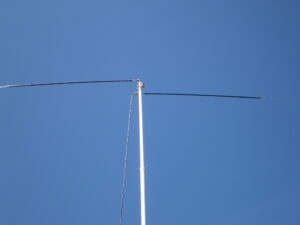
Wire antennas can be dipoles, loops or endfed antennas. Usually there is insufficient room for half wave dipoles, except for ten meters. Shortened dipoles are possible but as the antenna gets shorter the band width get smaller. Many experimenters have found that the dipole as short as ¼ wavelength can be efficient if the RF can be matched properly to the antenna. Coils and traps add losses to the antenna.


Of course, if allowed, half wave antennas can be installed on the roof. Or they can be installed around the ceilings or walls of a room or in an attic space. “Slinky” toys have been used to make antennas also. They can be end fed with an unun balun and matchbox or using two to make a shortened dipole. They can be strung on a plastic line, pvc pipe or telescoping fishing pole. This makes them easily hidden when not in use.
Another possibility is a shortened dipole about 44 to 50 feet long, center fed with balanced feed line or two lengths of TV coax, using the center conductors as the feed line. The shields should be connected at each end and the shack end grounded if possible.
If each half is wound around a 7 meter telescoping fishing pole the antenna can be mounted on a balcony railing, pointing away from the building. This will make a multiband antenna for 40 to 10 meters. One half can be on the pole and one half hanging vertical also. Just make sure the hanging side does not hit apartments or people below. These antennas require a matchbox to feed RF from the transmitter to the feedline. The internal antenna tuners in most modern transceivers do not have enough range to match them on all bands.


End fed wire on a telescoping fishing pole. The far end hangs down.

End fed wires are possible using a 49 :1 balun and 33 to 72 feet of antenna wire. The wire runs from the balcony or window to a tree or support away from the building. The antenna should not cross any power lines or be where people can contact the wire.
Verticals or semi-verticals can be installed on balconies. Perhaps a 15 foot aluminum tubing vertical mounted on the railing with a 15 foot wire counterpoise hanging down fed with a tuner and short coax feedline or a balanced line. This should make a good antenna for 20 to 10 meters and possibly used on 40 and 30 meters with less efficiency depending on the tuner.

This is a DIY TAKTENNA with Petlowany coils on each end making a short vertical dipole.
Antennas for stealth, limited areas or apartments are a challenge but there are many ideas available on the internet. Just allow your mind to think out-side-the-box and visualize different antenna installations.
For more info and ideas on apartment antennas I suggest this URL:
https://officinahf.jimdofree.com/antenne-hf-mf/hf-antenne-da-balcone-1/
My thanks to the many that have purchased my new book: “Basic Wire Antennas for Hams and Preppers” as shown below. Send $5.00 US to my email address via PayPal for a PDF copy. W4BWS1 at gmail. com. More info at QRZ.com/db/W4BWS. Be sure to include your email address with the PayPal order.

As Rick Barrow, K3IW writes: Dear Dr. Don, Thank you very much, I enjoyed perusing your new antenna book. After reading it the work is worth more than five bucks, but I don’t know if youngsters read much these days versus watching YouTube instructional videos.
Dr. Donald Sanders, W4BWS, is a special contributor and writes from Florida, USA.
 LHS Episode #372: Pond Scum
LHS Episode #372: Pond Scum
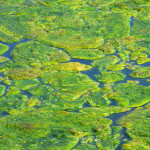
Welcome to the 372nd installment of Linux in the Ham Shack. In this episode, we have a rogue co-host join the crew for stories about Jamboree on the Air/Internet, Supreme Court cases of a deeply important nature, revised band plans, losing frequencies, graphical WSL, GPL enforcement, the pre-release WSJT-X and much more. Thank you for listening and have a wonderful week.
73 de The LHS Crew
Russ Woodman, K5TUX, co-hosts the Linux in the Ham Shack podcast which is available for download in both MP3 and OGG audio format. Contact him at [email protected].

